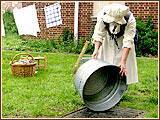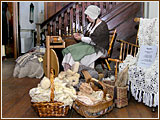SHEEP AND WOOL IN COLONIAL LIFE
Demonstration Spotlights a Fuzzy 18th-Century Craft

Photography by Hoag Levins ...| ...April 26, 2004



|
|
CAMDEN, N.J. -- The annual Family Fun Day at the Camden County Historical Society is a 'Living History' festival that demonstrates the historic realities, crafts and artifacts of local 18th-century life. This year's program featured a 'Sheep-to-Shawl' event that began with the off-site shearing of a sheep. The raw wool (above, right) was delivered to the side yard of Pomona Hall, the Society's 18th-century mansion. Also see larger photo.

|
|


|
|
The raw wool is thick with lanolin, the animal's natural oil, as well as debris from the pasture. Sandy Levins, trustee and program director of the Society, disposes wash water after having immersed the wool in sudsy water, very gently squeezing it to prevent felting, or the irreversible interlocking of the wool's fibers. Afterward, the sopping wet but clean raw wool was laid on a clean sheet on bushes to dry. Also see larger photo

|
|


|
|
Inside Pomona Hall, Collingswood spinner Lois Fuller uses a spinning wheel to turn dried tufts of wool into single-ply yarn. The most frequent question asked by both children and adults during her demonstrations is, 'Do you have to kill the sheep to get the wool?,' she said. 'They are really concerned about whether or not the sheep gets hurt during any of this and are very glad to hear it doesn't.' Also see larger photo

|
|


|
|
Ms. Fuller, who has been a spinner for 16 years, often appears in area schools. In Pomona Hall yesterday, she encouraged interested visitors, young and old, to sit in her seat and actually spin the raw wool into yarn (above, left). On display were the finished skeins of yarn, shawls, table runners and other items made from the wool she spins. Also see larger photo

|
|
|



